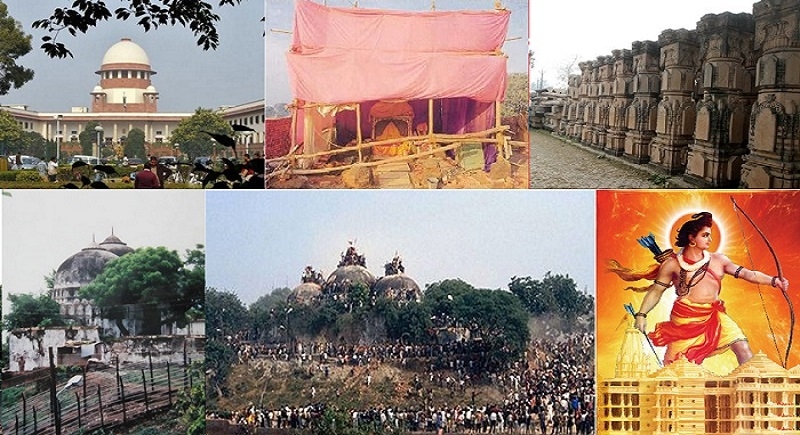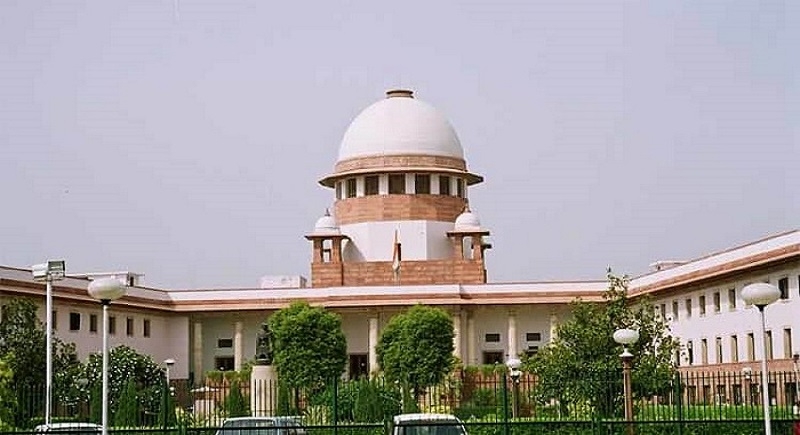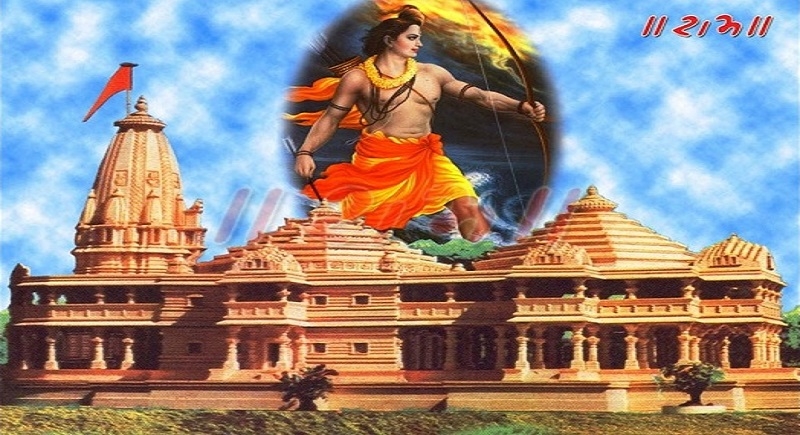Ram Mandir - Judiciary must deliver verdict one way or other!

With great anticipation, people are expecting the Supreme Court (SC) to close the hearings of Ram Mandir on 17 October 2019 and deliver a decisive verdict a month later – before the Chief Justice of India Ranjan Gogoi retires. In anticipation, curfew has been already imposed in Ayodhya.
By the quote “Justice Delayed is Justice Denied”, the responsibility for further prevarication on Ram Mandir crisis resolution falls on the SC. Be that as it may, the judicial delay is no more acceptable to people at large. In spite of the delays, the judiciary is still held in highest esteem for upholding the Constitution and rule of law.
The BJP’s stance is clear. An ordinance to build a Ram Mandir would arise only after the SC delivers its verdict. After all, Prime Minister Modi stated, “The ordinance on triple talaq was brought only after the verdict of SC. We want the issue to be solved within the framework of Constitution. The ordinance on Ram Mandir can arise only after legal process gets over and SC gives its verdict.” Moreover, the Prime Minister criticized the Congress Party for indulging in dual postures to make political gains.
Quite prophetic is the reflection of K N Panikar, Professor of Modern History, JNU, who stated after the Babri Masjid demolitions: “While the partition was culmination of the communal movement, Ayodhya is not necessarily the end. It might well be the beginning of a major political catastrophe”.
Also, the sane advice of Justice VR Krishna Iyer is relevant: “We want judicial finality, not political expediency from a tottering cabal called Cabinet”. The second issue which is raised by him is that “even if it binds the Rashtrapati, the several other issues raised in the Lucknow litigation will still have to be fought, and like festering wounds, this pendency will keep alive the fell feuds”.
Talk to local students in Ayodhya, they would abide by whatever judgment the SC could deliver before the present Chief Justice of India, Ranjan Gogoi retires on 17th November 2019. For VHP’s Ram Janmabhoomi Karyashala, “We are waiting for the judgment.” Otherwise, a new 5-judge bench will have to be reconstituted to hear the arguments of the case all over thereby delaying the final verdict.
Locals accuse politicians for sowing seeds of distrust by using religion to divert attention from real issues – development and jobs. And, the State BJP government has promised to develop Ayodhya as Smart City, Rs 174 crore for a medical college (almost ready), Rs 400 crore airport, a 221-metre Lord Ram Statue, to be highest in the world and Rs 31-crore revamp of the area along Sarayu.
In retrospect, the SC has heard the Ram Mandir case well over ten times - what with the recent 5-Judge constitution Bench headed by the Chief Justice of India hearings that are supposed to end on 17 October 2019. And, the SC judgment is to be delivered a month later in November 2019 not only to adjudicate on an ordinary title dispute but also on other substantial issues before the Chief Justice of India retires that would only set the course for further procrastination and delay.
At the cost of repetition, let me in outline review the timeline of the Ram Janmabhoomi-Babri Masjid land dispute. Babur Nama, an authentic record of events of Babur, does not mention the name of Ayodhya or a visit to such a name place. Otherwise, Muslims claim that Babri Masjid was built in 1528 by Mir Baqi, commander of Mughal emperor Babur.
The first recorded bloody conflict occurred during the years 1853-55. A rebel Hindu Priest who turned Maulvi, attempted to capture the Shrine. He was killed by the combined forces of Nawab Wajid Ali Shah of Avadh and the British led by the First Irregular Infantry. The death toll was estimated between 120-700. Subsequently in 1855, the Muslims captured the shrine. But by a fierce counter attack, the Hindu Bairagis recaptured it and killed 75 Muslims.
In 1885, Mahant Raghubir Das files plea in Faizabad district court seeking permission to build a canopy outside the disputed Ram Janmabhoomi-Babri Masjid structure. But, the Court rejected his plea. Thus, the “Ram Mandir Logjam” is over 134 years.

Second, in 1950s Gopal Simla Visharad and Paramhans Ramachandra Das filed suits in Faizabad district court for rights to keep and worship the idols of Ram Lalla. Third, on 17 December 1959, the Nirmohi Akhara filed a suit seeking possession of the site and claims to be the custodians of the disputed land followed on 18 December 1961 by the Sunni Central Board of Waqf filing a suit claiming ownership of the site.
Following the “Shah Bano Case” verdict in 1984, the Congress Party is responsible for the politicization of Ram Mandir issue, as part of its “Appeasement Politics” strategy. In retaliation, the Vishwa Hindu Parishad (VHP) spearheaded a movement to 'liberate' the birth-place of Lord Ram and build a temple. Then Bharatiya Janata Party (BJP) leader LK Advani took over leadership of campaign.
Fourth, in 1986 Rajiv Gandhi and Arun Nehru persuaded the then UP chief minister Bir Bahadur Singh to open the lock and allowed religious rites to take place inside the disputed structure as part of the Congress Party “Appeasement Politics” strategy. This triggered a mass movement by the VHP which launched agitation to break free the idols of Lord Rama and Sita from “captivity”. On 1 February, 1986, the district court ordered the gates of the mosque opened and Hindus allowed worshipping there. Muslims protested the move and formed Babri Mosque Action Committee.
Fifth, on 14 August, 1989, the Allahabad HC bunched together the four petitions regarding the dispute over Babri Masjid and ordered that status quo be maintained. Sixth, on 9 November 1989, following permission from the Rajiv Gandhi government as a pre poll carrot, VHP laid the foundation of a Ram temple on land next to the Babri Masjid.
Seventh, the Babri Masjid was demolished on 6 December 1992 familiarly referred in the media as the “Black Sunday.” Media publicized it and blamed communalists on either side besides the politicians. The Central government acquired lands in the disputed area. Writ petitions, including one by Ismail Faruqui, filed at Allahabad HC challenging various aspects of the Act. Subsequently, the SC in October 1994 passed its judgment in the Ismail Faruqui case that the mosque was not integral to Islam.
Add to it, recent highlights of judicial references in the new millennium. One, in April 2002, the 3-judge Bench of Allahabad HC ordered the Archaeological Survey of India (ASI) to excavate the site to determine if it was a temple earlier. And, the ASI in August 2003 found features of 10th Century temple and submitted its report to the Allahabad HC.
Two, the SC re-entered the scene in March 2003 and gave a verdict in the Aslam alias Bhure case that “no religious activity of any nature be allowed at the acquired land.” The SC interim order should be operative till disposal of the civil suits in Allahabad HC to maintain communal harmony.
Three, after a delay of over 7-years, the HC on 30 September 2010 ordered that the 2.77 acre disputed site be divided into three parts among the Hindus, the Muslims and the Nirmohi Akhara. But, All India Muslim Personal Law Board challenged the ASI report. The HC reserved its judgment and advised all parties to solve the issue amicably in July 26, 2010. On 23 September, the plea for an out-of-court settlement reached SC who adjourned it to hear again on 28 September.
Subsequently, the HC announced to pronounce the verdict on 24 September, but deferred the judgment on a writ petition. The SC rejected petition for deferment and gave the nod to the Allahabad HC to deliver judgment.
Four, on 9 May 2011, the SC stayed the verdict of the HC on petitions filed by Mahant Suresh Das, the Sunni Central Board of Wakfs, Nirmohi Akhara, the Akhil Bharat Hindu Mahasabha, Jamait Ulama-I-Hind and others challenging the verdict. A petition was also filed on behalf of Ram Lalla challenging the HC verdict.
Five, on 26 February, 2016, Subramanian Swamy filed plea in SC that sought construction of Ram Temple to begin at the disputed site. However, on 21 March, 2017, the SC stated that the matter is sensitive and suggested it to be settled out of court to find an amicable solution.
Six, on 7 August 2017, the SC constituted 3-judge bench to hear pleas challenging the 1994 verdict of Allahabad HC. On 8 August 2017, UP Shia Central Waqf Board told the SC that the mosque can be built in a Muslim-dominated area at a reasonable distance from the disputed site. Also, on 20 November 2017, the UP Shia Central Waqf Board told the SC that the temple can be built in Ayodhya and mosque in Lucknow. On 11 August, 2017, the SC scheduled hearing of 13 appeals in the title dispute on December 5, 2017, coinciding with the eve of the 25th anniversary of the desecration of the Babri mosque. Meanwhile, 32-civil rights activists file plea challenging the 2010 verdict of the Allahabad HC. And, the SC stated that it will hear the civil appeals filed by various parties challenging the 2010 Allahabad HC verdict on 8 February, 2018.
After hearing the civil appeals commencing on 8 February 2018, the SC on 14 March, 2018 rejected all interim pleas, including Swamy’s, seeking to intervene as parties in the case. It was followed on 16 April 2018 by Rajeev Dhavan plea in SC to refer the issue of reconsideration of the observations in its 1994 judgment to a larger bench. Seven on 27 September 2018, the SC declined to refer the case to a 5-judge Constitution bench and the case to be heard by a newly constituted 3-judge bench on 29 October 2018 and clarified that it would have no bearing on pending title suits.
In October 2018, the SC decided that the land dispute case will only be listed before an “appropriate Bench” in January 2019 by the Bench consisting Chief Justice Gogoi and Justices S K Kaul and K M Joseph and stated “the appropriate Bench will fix the schedule with regard to the hearing of appeals in the case”.
All over again on 4 January, 2019, the SC deferred hearing a bunch of petitions in the title dispute case till January 10 and stated that “orders will be passed by an appropriate bench on January 10 for fixing the date of hearing the matter.”
Finally, on 8 January, 2019, the SC set up a 5-judge Constitution Bench to hear the land dispute case. Meanwhile, Justice UU Lalit recused from the Bench. And, on 10 January, 2019, the 5-judge Constitution Bench presently is hearing the arguments of both sides and set 17 October as the deadline.
Yet another significant Ram Mandir issue is its politicization. The Congress Party – Nehru and Rajiv Gandhi too favoured Hindu stand by their actions in 1949 by placing idols and allowing Shilanyas in 1989 - is squarely responsible for stoking the political crisis due to its “Appeasement Politics” strategy. The government declared the site as disputed and locked the gates to it. Both sides filed cases.
Jumped into the fray the VHP and followed by the then BJP President L K Advani Rath Yatra from Somnath to Ayodhya on 25 September 1990, who was arrested in Bihar’s Samastipur in November. Later, VHP volunteers partially damaged the mosque and Prime Minister Chandra Shekhar tried to resolve the dispute through negotiations. In 2002, BJP ruled out committing itself to the construction of a temple in its election manifesto for Uttar Pradesh assembly elections. VHP confirmed deadline of 15 March to begin construction. Hundreds of volunteers converged on site. At least 58 people were killed in an attack on a train in Godhra which was carrying Hindu activists returning from Ayodhya. Followed the communal violence in Gujarat in March 2002 where hundreds of people died were killed. In July 2005, suspected militants attack the makeshift Ram temple. All five militants were killed by the CRPF.
Add to it, the issue of charges of criminal conspiracy against Advani, Murali Manohar Joshi, Uma Bharati and Vinaya Katiyar in the demolition case. Next, in September 2003 a court ruled that seven Hindu leaders should stand trial for inciting the destruction of the Babri Mosque. No charges were brought against Advani. However, in November 2004, a court in Uttar Pradesh ruled that LK Advani's role in the demolition be reviewed. As of March 2017, the SC has not dropped the case against them.
Even the out-of-court settlement initiatives need to be recounted. Vajpayee had set up an Ayodhya cell in his office and appointed Shatrughan Sinha, to hold talks with Hindu and Muslim leaders. Even the recent Sri Sri Ravi Shankar initiatives have failed to provide a breakthrough who remarked prophetically “India will turn into Syria over Ram Temple.”
The “Soft Hindutva” strategy of the Rahul Gandhi led Congress Party to reclaim its lost ground in the Hindi-North India belt is borne out its post-1989 elections strategy.
Of course, media, which is the sinister manipulator behind the scenes shaping people’s perceptions as the problem, is equally to be blamed. The partisan media is part of the problem complexity. Some of them are culpable of not sharing ‘facts’ of the dispute accurately to people.
Viewed against the above background, who is responsible for the ongoing Ram Mandir crisis faux pas or impasse? The root cause is simple. The Hindus hurt psyche, must be appreciated in historical context. Historic-analytically, the theory of waning Hinduism is real. It is under a virtual siege on its own soil. From the dizzy heights of nearly 50% of World population in 001 AD, its slide to 14% is real today. It is the last of ancient religions. It has every reason and right to protect its own interests on its own soil.

Next, the politics over secularism vs. communalism continues to obfuscate realities. What needs to be accepted and must be recognized is that 15 August 1947 was stunning defeat for secularism. Undeniably, the idealist secular Generals lost. They refused to recognize the writing on the wall – if Pakistan was born on the basis of religion, as a corollary, even India too was born on religious basis only.
Most important, even our intellectuals and media displayed woeful lack of concern to the total denigration of secularism in our North Eastern States or Kashmir valley. Never have they highlighted ever before the near 100% captivation of the Mongoloid race and their total resistance to intrusion of any other religions due to Nehruvian faulty policies that allowed “Baptization”.
Most critical is the hypocrisy of international community. For them, the destruction of Babri Masjid is highly provocative on the part of the Hindus, whereas the destruction of over 40 temples since 1989 in Kashmir valley or the 4th migration of Kashmiri Hindus or the destruction of 245 temples in retaliation of Babri Masjid demolition in Pakistan hardly stirs their conscience. Also, Iran, Saudi Arabia, Algiers and other Muslim nations have demolished Masjid for the sake of modernization. Even in Karbala, large scale additions/alterations have been carried out for Haz pilgrims around the main shrine.
Finally, the judicial delay in adjudicating such sensitive issue is only contributing to further exacerbating the socio-political divide. The fact about the existence of Shrine below the Babri Mosque site has been confirmed. As per Islamic traditions, it is ‘haram’ to build a Mosque on illegal taken land. In my perception, it is naïve to expect that all Muslims will abide by such a Quranic authorization.
To sum up, the SC can ill afford to prevaricate over giving a decisive verdict one way or other before the present Chief Justice of India, GOGOI, retires on 17 November 2019, thereby justifying further procrastination over such key internal security concern. The SC must exploit the opportunity for the sake of retaining the confidence of “We the People of India” in its credibility.
